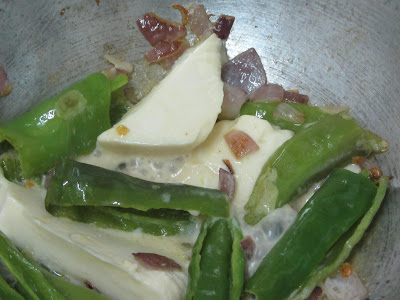While occasionally I will swear off rice because I have it almost every single meal, in general the food in Bhutan is fresh and tasty. I would say that while there are some unique aspects to Bhutanese cuisine, it mostly is a mixture of Indian and Tibetan influences. I do a lot of my own cooking at home, especially for dinner, and have access to an incredible array of local produce through the Centenary Market in Thimphu. Either the food you can find in Bhutan is local and fresh and unrefridgerated, or it is heavily processed and imported from Thailand, India, or Bangladesh. There's not a lot of in-between.
The other day I decided to try ema datse again, after the first round didn't go so well. Ema datse is the national dish of Bhutan, consisting of chiles and cheese. You can also find a third ingredient mixed in from time to time, including potatoes or mushrooms or tomatoes, for example. The first time around I used a local cheese that I had purchased at the market. Of course, the cheese was unrefridgerated (as is all meat, eggs, and dairy here). The cheese I purchased turned out to be really pungent yak cheese and was not only terrible for ema datse but also terrible for my stomach.
The second go-around I broke down and used processed cheese from Amul (big manufacturer of processed food in South Asia). Without a lot of local guidance about local cheese, this was suggested as a good alternative. It actually turned out pretty well.
Here's a break-down of a meal in Bhutan...
The other day I decided to try ema datse again, after the first round didn't go so well. Ema datse is the national dish of Bhutan, consisting of chiles and cheese. You can also find a third ingredient mixed in from time to time, including potatoes or mushrooms or tomatoes, for example. The first time around I used a local cheese that I had purchased at the market. Of course, the cheese was unrefridgerated (as is all meat, eggs, and dairy here). The cheese I purchased turned out to be really pungent yak cheese and was not only terrible for ema datse but also terrible for my stomach.
The second go-around I broke down and used processed cheese from Amul (big manufacturer of processed food in South Asia). Without a lot of local guidance about local cheese, this was suggested as a good alternative. It actually turned out pretty well.
Here's a break-down of a meal in Bhutan...
Buy some fresh chiles in the market and cut them into strips.
Leave the seeds in, if you are brave, or take them out if you are not.
Fry the chiles with onions in plenty of butter.
Once the chiles and onions have softened, add the cheese and water to get a nice soupy cheese.
Your pan will require some intensive cleaning afterwards.
And you've got ema datse! Dig in!
For this meal, I also made a nice vegetable curry with local vegetables:
cauliflower, carrots, beans, eggplant, tomatoes, and, of course, dried chiles!
Finish off the meal with some amazing fresh mango!







Thanks for this cooking lesson, Matt. I always find the foods and cooking methods of other places in the world very interesting. Do you serve the ema datse on rice?
ReplyDeleteGenerally, ema datse is eaten alone as a side dish. Rice will always, always be part of every meal, so when you put everything on your plate it all ends up in the rice anyway.
ReplyDeleteIf you want to try it yourself, here's a pretty decent Americanized recipe: http://delectable-victuals.blogspot.com/2009/09/ema-datsi-from-druk-yul.html